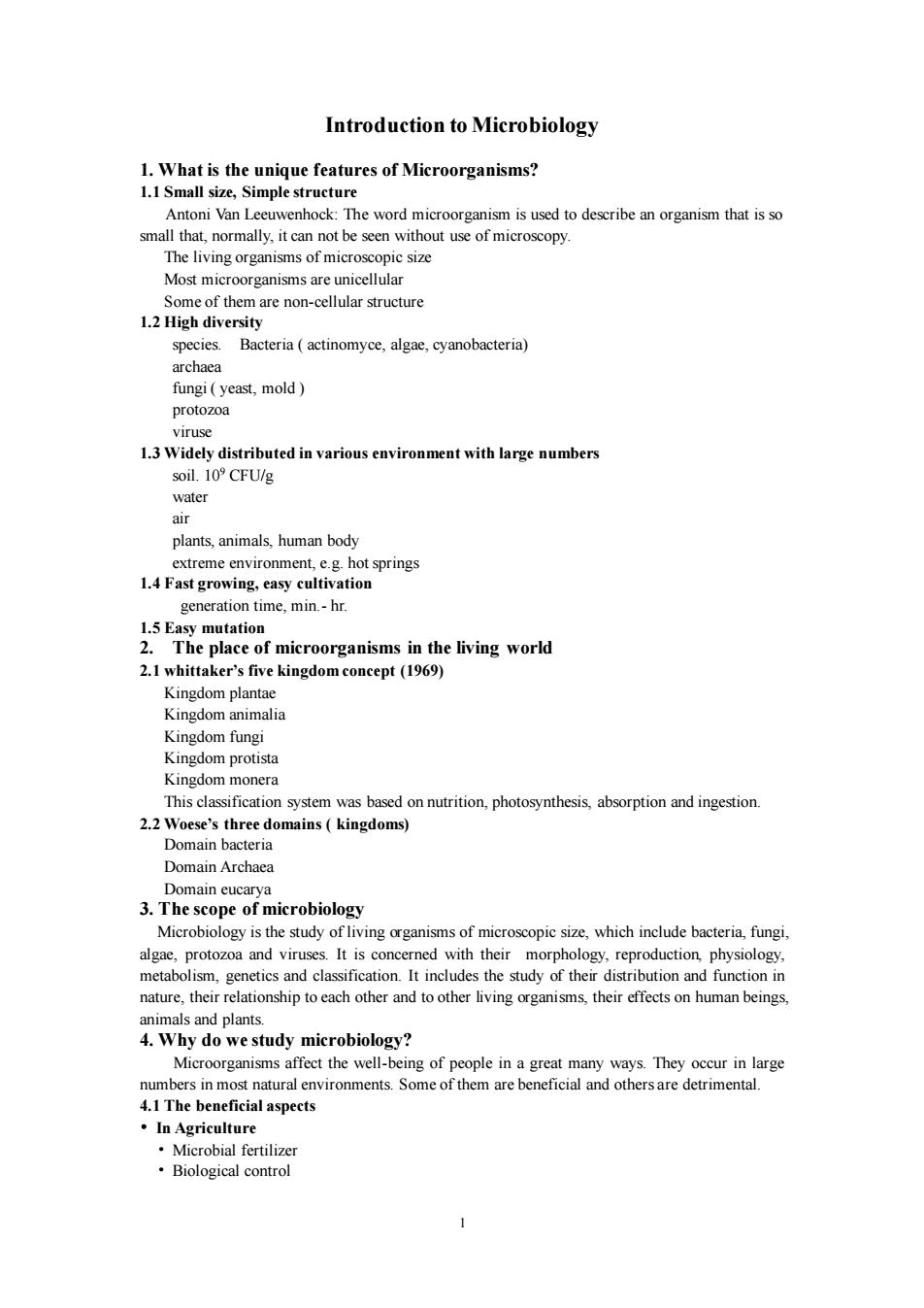
1 Introduction to Microbiology 1. What is the unique features of Microorganisms? 1.1 Small size, Simple structure Antoni Van Leeuwenhock: The word microorganism is used to describe an organism that is so small that, normally, it can not be seen without use of microscopy. The living organisms of microscopic size Most microorganisms are unicellular Some of them are non-cellular structure 1.2 High diversity species. Bacteria ( actinomyce, algae, cyanobacteria) archaea fungi ( yeast, mold ) protozoa viruse 1.3 Widely distributed in various environment with large numbers soil. 109 CFU/g water air plants, animals, human body extreme environment, e.g. hot springs 1.4 Fast growing, easy cultivation generation time, min.- hr. 1.5 Easy mutation 2. The place of microorganisms in the living world 2.1 whittaker’s five kingdom concept (1969) Kingdom plantae Kingdom animalia Kingdom fungi Kingdom protista Kingdom monera This classification system was based on nutrition, photosynthesis, absorption and ingestion. 2.2 Woese’s three domains ( kingdoms) Domain bacteria Domain Archaea Domain eucarya 3. The scope of microbiology Microbiology is the study of living organisms of microscopic size, which include bacteria, fungi, algae, protozoa and viruses. It is concerned with their morphology, reproduction, physiology, metabolism, genetics and classification. It includes the study of their distribution and function in nature, their relationship to each other and to other living organisms, their effects on human beings, animals and plants. 4. Why do we study microbiology? Microorganisms affect the well-being of people in a great many ways. They occur in large numbers in most natural environments. Some of them are beneficial and others are detrimental. 4.1 The beneficial aspects • In Agriculture • Microbial fertilizer • Biological control
1 Introduction to Microbiology 1. What is the unique features of Microorganisms? 1.1 Small size, Simple structure Antoni Van Leeuwenhock: The word microorganism is used to describe an organism that is so small that, normally, it can not be seen without use of microscopy. The living organisms of microscopic size Most microorganisms are unicellular Some of them are non-cellular structure 1.2 High diversity species. Bacteria ( actinomyce, algae, cyanobacteria) archaea fungi ( yeast, mold ) protozoa viruse 1.3 Widely distributed in various environment with large numbers soil. 109 CFU/g water air plants, animals, human body extreme environment, e.g. hot springs 1.4 Fast growing, easy cultivation generation time, min.- hr. 1.5 Easy mutation 2. The place of microorganisms in the living world 2.1 whittaker’s five kingdom concept (1969) Kingdom plantae Kingdom animalia Kingdom fungi Kingdom protista Kingdom monera This classification system was based on nutrition, photosynthesis, absorption and ingestion. 2.2 Woese’s three domains ( kingdoms) Domain bacteria Domain Archaea Domain eucarya 3. The scope of microbiology Microbiology is the study of living organisms of microscopic size, which include bacteria, fungi, algae, protozoa and viruses. It is concerned with their morphology, reproduction, physiology, metabolism, genetics and classification. It includes the study of their distribution and function in nature, their relationship to each other and to other living organisms, their effects on human beings, animals and plants. 4. Why do we study microbiology? Microorganisms affect the well-being of people in a great many ways. They occur in large numbers in most natural environments. Some of them are beneficial and others are detrimental. 4.1 The beneficial aspects • In Agriculture • Microbial fertilizer • Biological control
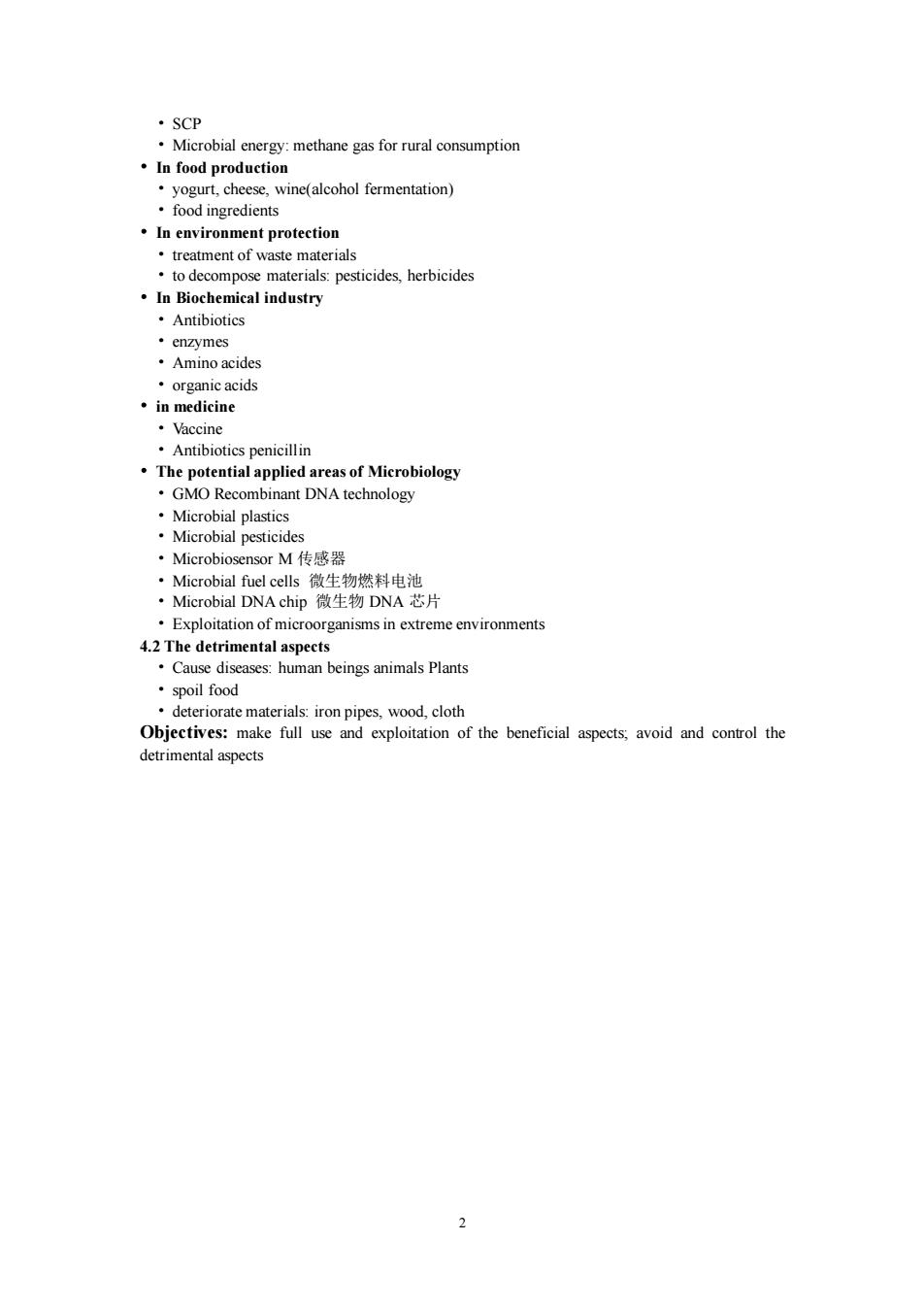
2 • SCP • Microbial energy: methane gas for rural consumption • In food production • yogurt, cheese, wine(alcohol fermentation) • food ingredients • In environment protection • treatment of waste materials • to decompose materials: pesticides, herbicides • In Biochemical industry • Antibiotics • enzymes • Amino acides • organic acids • in medicine • Vaccine • Antibiotics penicillin • The potential applied areas of Microbiology • GMO Recombinant DNA technology • Microbial plastics • Microbial pesticides • Microbiosensor M 传感器 • Microbial fuel cells 微生物燃料电池 • Microbial DNA chip 微生物 DNA 芯片 • Exploitation of microorganisms in extreme environments 4.2 The detrimental aspects • Cause diseases: human beings animals Plants • spoil food • deteriorate materials: iron pipes, wood, cloth Objectives: make full use and exploitation of the beneficial aspects; avoid and control the detrimental aspects
2 • SCP • Microbial energy: methane gas for rural consumption • In food production • yogurt, cheese, wine(alcohol fermentation) • food ingredients • In environment protection • treatment of waste materials • to decompose materials: pesticides, herbicides • In Biochemical industry • Antibiotics • enzymes • Amino acides • organic acids • in medicine • Vaccine • Antibiotics penicillin • The potential applied areas of Microbiology • GMO Recombinant DNA technology • Microbial plastics • Microbial pesticides • Microbiosensor M 传感器 • Microbial fuel cells 微生物燃料电池 • Microbial DNA chip 微生物 DNA 芯片 • Exploitation of microorganisms in extreme environments 4.2 The detrimental aspects • Cause diseases: human beings animals Plants • spoil food • deteriorate materials: iron pipes, wood, cloth Objectives: make full use and exploitation of the beneficial aspects; avoid and control the detrimental aspects
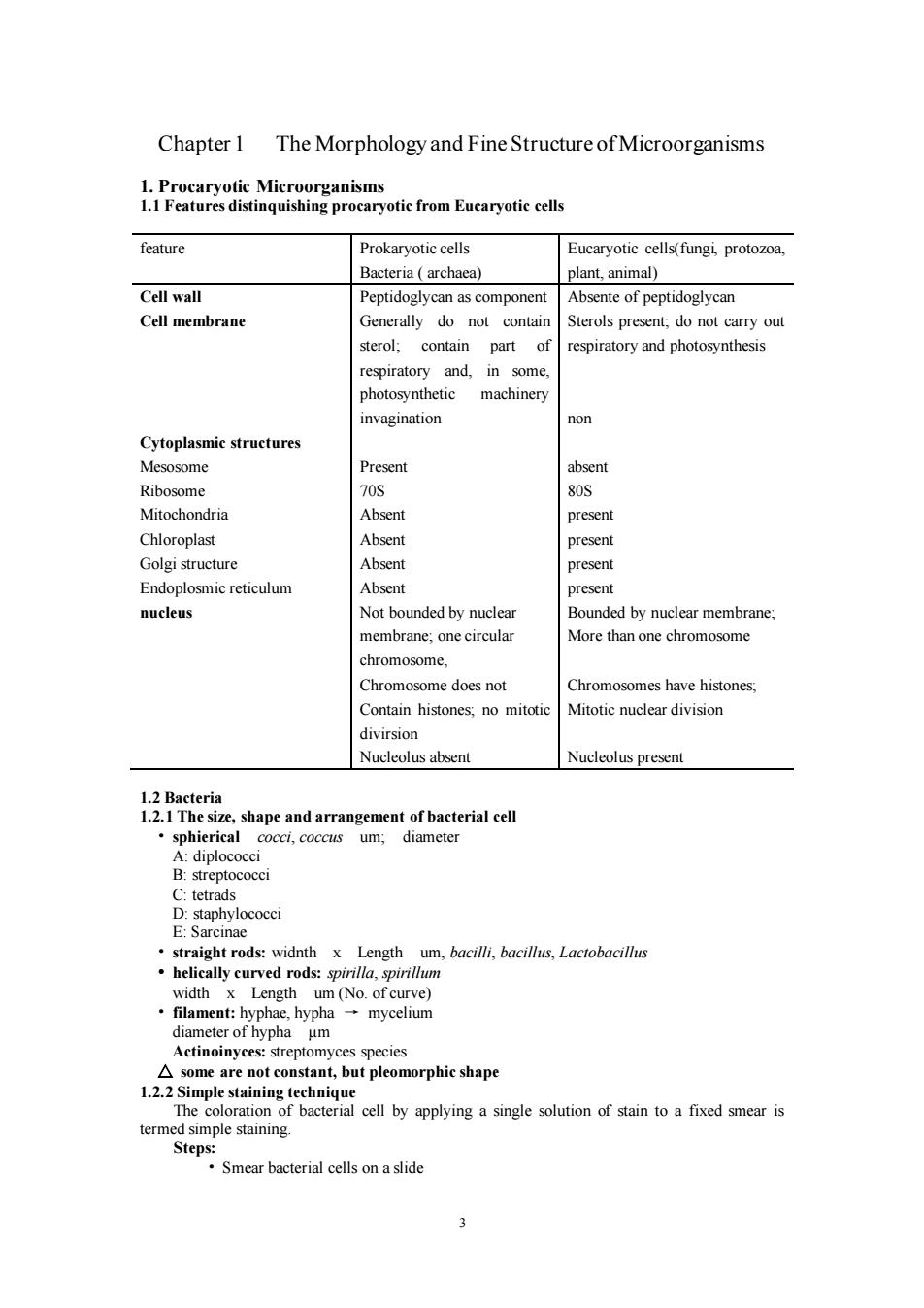
3 Chapter 1 The Morphology and Fine Structure of Microorganisms 1. Procaryotic Microorganisms 1.1 Features distinquishing procaryotic from Eucaryotic cells feature Prokaryotic cells Bacteria ( archaea) Eucaryotic cells(fungi, protozoa, plant, animal) Cell wall Cell membrane Cytoplasmic structures Mesosome Ribosome Mitochondria Chloroplast Golgi structure Endoplosmic reticulum nucleus Peptidoglycan as component Generally do not contain sterol; contain part of respiratory and, in some, photosynthetic machinery invagination Present 70S Absent Absent Absent Absent Not bounded by nuclear membrane; one circular chromosome, Chromosome does not Contain histones; no mitotic divirsion Nucleolus absent Absente of peptidoglycan Sterols present; do not carry out respiratory and photosynthesis non absent 80S present present present present Bounded by nuclear membrane; More than one chromosome Chromosomes have histones; Mitotic nuclear division Nucleolus present 1.2 Bacteria 1.2.1 The size, shape and arrangement of bacterial cell • sphierical cocci, coccus um; diameter A: diplococci B: streptococci C: tetrads D: staphylococci E: Sarcinae • straight rods: widnth x Length um, bacilli, bacillus, Lactobacillus • helically curved rods: spirilla, spirillum width x Length um (No. of curve) • filament: hyphae, hypha → mycelium diameter of hypha μm Actinoinyces: streptomyces species △ some are not constant, but pleomorphic shape 1.2.2 Simple staining technique The coloration of bacterial cell by applying a single solution of stain to a fixed smear is termed simple staining. Steps: • Smear bacterial cells on a slide
3 Chapter 1 The Morphology and Fine Structure of Microorganisms 1. Procaryotic Microorganisms 1.1 Features distinquishing procaryotic from Eucaryotic cells feature Prokaryotic cells Bacteria ( archaea) Eucaryotic cells(fungi, protozoa, plant, animal) Cell wall Cell membrane Cytoplasmic structures Mesosome Ribosome Mitochondria Chloroplast Golgi structure Endoplosmic reticulum nucleus Peptidoglycan as component Generally do not contain sterol; contain part of respiratory and, in some, photosynthetic machinery invagination Present 70S Absent Absent Absent Absent Not bounded by nuclear membrane; one circular chromosome, Chromosome does not Contain histones; no mitotic divirsion Nucleolus absent Absente of peptidoglycan Sterols present; do not carry out respiratory and photosynthesis non absent 80S present present present present Bounded by nuclear membrane; More than one chromosome Chromosomes have histones; Mitotic nuclear division Nucleolus present 1.2 Bacteria 1.2.1 The size, shape and arrangement of bacterial cell • sphierical cocci, coccus um; diameter A: diplococci B: streptococci C: tetrads D: staphylococci E: Sarcinae • straight rods: widnth x Length um, bacilli, bacillus, Lactobacillus • helically curved rods: spirilla, spirillum width x Length um (No. of curve) • filament: hyphae, hypha → mycelium diameter of hypha μm Actinoinyces: streptomyces species △ some are not constant, but pleomorphic shape 1.2.2 Simple staining technique The coloration of bacterial cell by applying a single solution of stain to a fixed smear is termed simple staining. Steps: • Smear bacterial cells on a slide
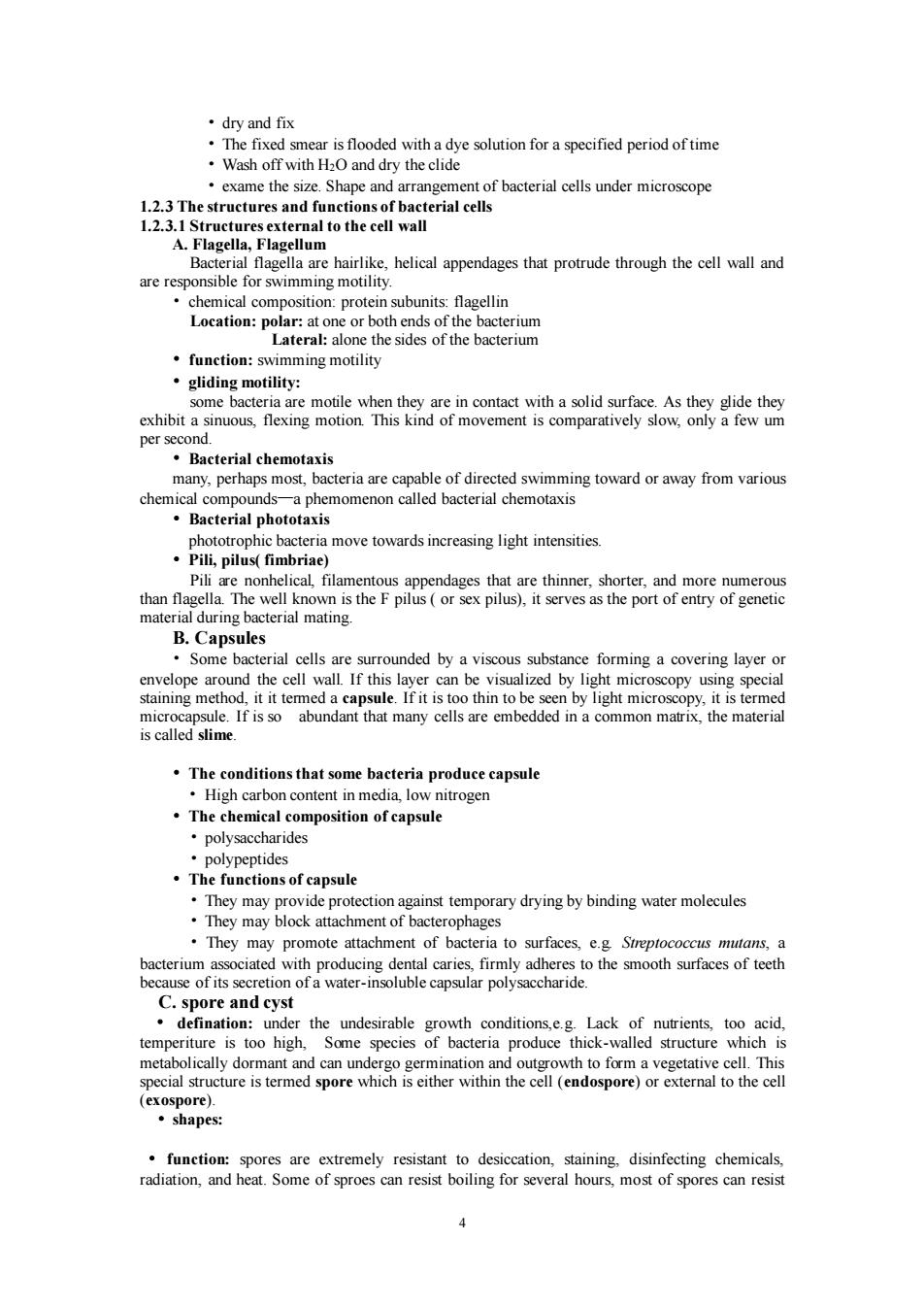
4 • dry and fix • The fixed smear is flooded with a dye solution for a specified period of time • Wash off with H2O and dry the clide • exame the size. Shape and arrangement of bacterial cells under microscope 1.2.3 The structures and functions of bacterial cells 1.2.3.1 Structures external to the cell wall A. Flagella, Flagellum Bacterial flagella are hairlike, helical appendages that protrude through the cell wall and are responsible for swimming motility. • chemical composition: protein subunits: flagellin Location: polar: at one or both ends of the bacterium Lateral: alone the sides of the bacterium • function: swimming motility • gliding motility: some bacteria are motile when they are in contact with a solid surface. As they glide they exhibit a sinuous, flexing motion. This kind of movement is comparatively slow, only a few um per second. • Bacterial chemotaxis many, perhaps most, bacteria are capable of directed swimming toward or away from various chemical compounds—a phemomenon called bacterial chemotaxis • Bacterial phototaxis phototrophic bacteria move towards increasing light intensities. • Pili, pilus( fimbriae) Pili are nonhelical, filamentous appendages that are thinner, shorter, and more numerous than flagella. The well known is the F pilus ( or sex pilus), it serves as the port of entry of genetic material during bacterial mating. B. Capsules • Some bacterial cells are surrounded by a viscous substance forming a covering layer or envelope around the cell wall. If this layer can be visualized by light microscopy using special staining method, it it termed a capsule. If it is too thin to be seen by light microscopy, it is termed microcapsule. If is so abundant that many cells are embedded in a common matrix, the material is called slime. • The conditions that some bacteria produce capsule • High carbon content in media, low nitrogen • The chemical composition of capsule • polysaccharides • polypeptides • The functions of capsule • They may provide protection against temporary drying by binding water molecules • They may block attachment of bacterophages • They may promote attachment of bacteria to surfaces, e.g. Streptococcus mutans, a bacterium associated with producing dental caries, firmly adheres to the smooth surfaces of teeth because of its secretion of a water-insoluble capsular polysaccharide. C. spore and cyst • defination: under the undesirable growth conditions,e.g. Lack of nutrients, too acid, temperiture is too high, Some species of bacteria produce thick-walled structure which is metabolically dormant and can undergo germination and outgrowth to form a vegetative cell. This special structure is termed spore which is either within the cell (endospore) or external to the cell (exospore). • shapes: • function: spores are extremely resistant to desiccation, staining, disinfecting chemicals, radiation, and heat. Some of sproes can resist boiling for several hours, most of spores can resist
4 • dry and fix • The fixed smear is flooded with a dye solution for a specified period of time • Wash off with H2O and dry the clide • exame the size. Shape and arrangement of bacterial cells under microscope 1.2.3 The structures and functions of bacterial cells 1.2.3.1 Structures external to the cell wall A. Flagella, Flagellum Bacterial flagella are hairlike, helical appendages that protrude through the cell wall and are responsible for swimming motility. • chemical composition: protein subunits: flagellin Location: polar: at one or both ends of the bacterium Lateral: alone the sides of the bacterium • function: swimming motility • gliding motility: some bacteria are motile when they are in contact with a solid surface. As they glide they exhibit a sinuous, flexing motion. This kind of movement is comparatively slow, only a few um per second. • Bacterial chemotaxis many, perhaps most, bacteria are capable of directed swimming toward or away from various chemical compounds—a phemomenon called bacterial chemotaxis • Bacterial phototaxis phototrophic bacteria move towards increasing light intensities. • Pili, pilus( fimbriae) Pili are nonhelical, filamentous appendages that are thinner, shorter, and more numerous than flagella. The well known is the F pilus ( or sex pilus), it serves as the port of entry of genetic material during bacterial mating. B. Capsules • Some bacterial cells are surrounded by a viscous substance forming a covering layer or envelope around the cell wall. If this layer can be visualized by light microscopy using special staining method, it it termed a capsule. If it is too thin to be seen by light microscopy, it is termed microcapsule. If is so abundant that many cells are embedded in a common matrix, the material is called slime. • The conditions that some bacteria produce capsule • High carbon content in media, low nitrogen • The chemical composition of capsule • polysaccharides • polypeptides • The functions of capsule • They may provide protection against temporary drying by binding water molecules • They may block attachment of bacterophages • They may promote attachment of bacteria to surfaces, e.g. Streptococcus mutans, a bacterium associated with producing dental caries, firmly adheres to the smooth surfaces of teeth because of its secretion of a water-insoluble capsular polysaccharide. C. spore and cyst • defination: under the undesirable growth conditions,e.g. Lack of nutrients, too acid, temperiture is too high, Some species of bacteria produce thick-walled structure which is metabolically dormant and can undergo germination and outgrowth to form a vegetative cell. This special structure is termed spore which is either within the cell (endospore) or external to the cell (exospore). • shapes: • function: spores are extremely resistant to desiccation, staining, disinfecting chemicals, radiation, and heat. Some of sproes can resist boiling for several hours, most of spores can resist
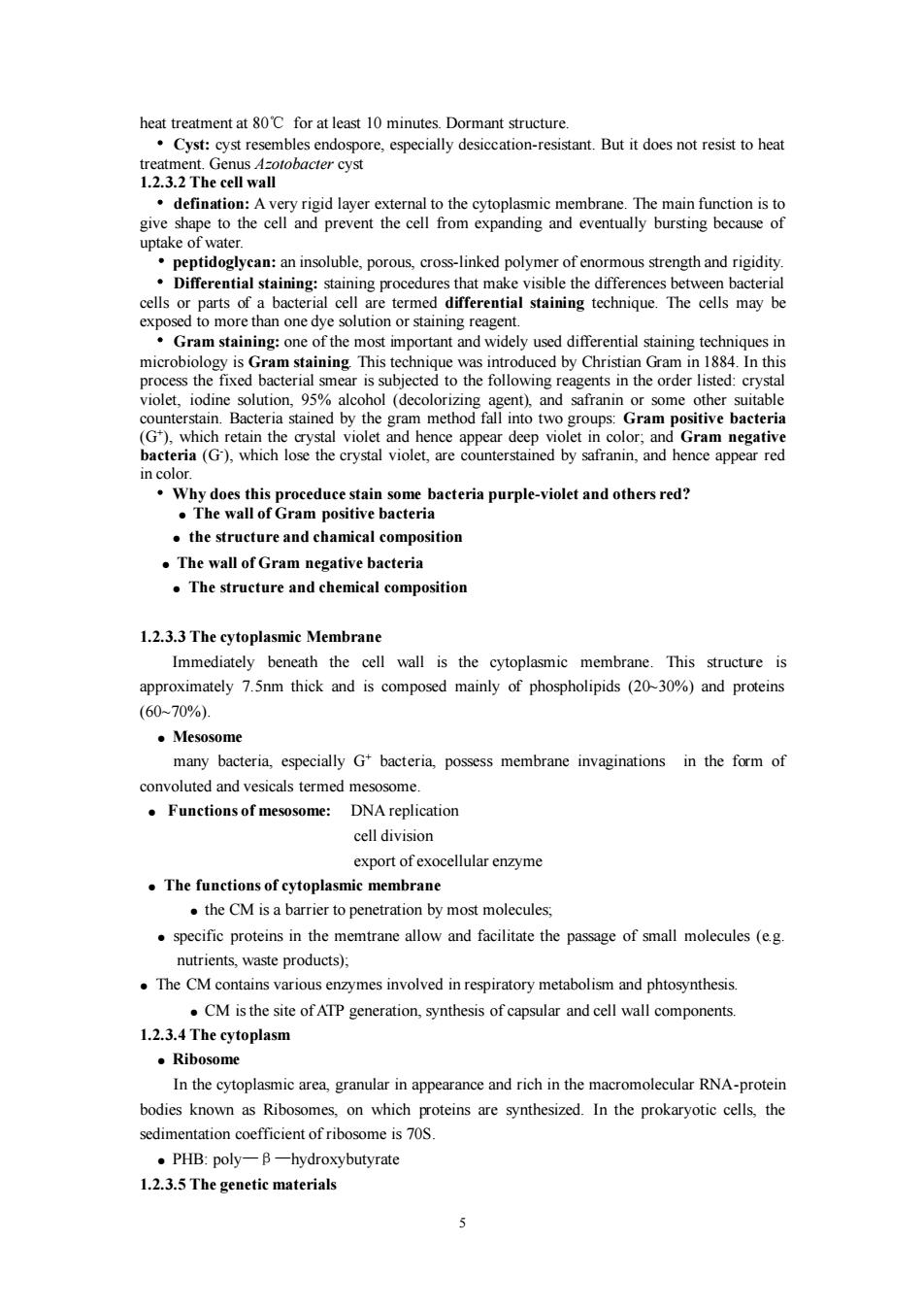
5 heat treatment at 80℃ for at least 10 minutes. Dormant structure. • Cyst: cyst resembles endospore, especially desiccation-resistant. But it does not resist to heat treatment. Genus Azotobacter cyst 1.2.3.2 The cell wall • defination: A very rigid layer external to the cytoplasmic membrane. The main function is to give shape to the cell and prevent the cell from expanding and eventually bursting because of uptake of water. • peptidoglycan: an insoluble, porous, cross-linked polymer of enormous strength and rigidity. • Differential staining: staining procedures that make visible the differences between bacterial cells or parts of a bacterial cell are termed differential staining technique. The cells may be exposed to more than one dye solution or staining reagent. • Gram staining: one of the most important and widely used differential staining techniques in microbiology is Gram staining. This technique was introduced by Christian Gram in 1884. In this process the fixed bacterial smear is subjected to the following reagents in the order listed: crystal violet, iodine solution, 95% alcohol (decolorizing agent), and safranin or some other suitable counterstain. Bacteria stained by the gram method fall into two groups: Gram positive bacteria (G+ ), which retain the crystal violet and hence appear deep violet in color; and Gram negative bacteria (G- ), which lose the crystal violet, are counterstained by safranin, and hence appear red in color. • Why does this proceduce stain some bacteria purple-violet and others red? ● The wall of Gram positive bacteria ● the structure and chamical composition ● The wall of Gram negative bacteria ● The structure and chemical composition 1.2.3.3 The cytoplasmic Membrane Immediately beneath the cell wall is the cytoplasmic membrane. This structure is approximately 7.5nm thick and is composed mainly of phospholipids (20~30%) and proteins (60~70%). ● Mesosome many bacteria, especially G+ bacteria, possess membrane invaginations in the form of convoluted and vesicals termed mesosome. ● Functions of mesosome: DNA replication cell division export of exocellular enzyme ● The functions of cytoplasmic membrane ● the CM is a barrier to penetration by most molecules; ● specific proteins in the memtrane allow and facilitate the passage of small molecules (e.g. nutrients, waste products); ● The CM contains various enzymes involved in respiratory metabolism and phtosynthesis. ● CM is the site of ATP generation, synthesis of capsular and cell wall components. 1.2.3.4 The cytoplasm ● Ribosome In the cytoplasmic area, granular in appearance and rich in the macromolecular RNA-protein bodies known as Ribosomes, on which proteins are synthesized. In the prokaryotic cells, the sedimentation coefficient of ribosome is 70S. ● PHB: poly—β—hydroxybutyrate 1.2.3.5 The genetic materials
5 heat treatment at 80℃ for at least 10 minutes. Dormant structure. • Cyst: cyst resembles endospore, especially desiccation-resistant. But it does not resist to heat treatment. Genus Azotobacter cyst 1.2.3.2 The cell wall • defination: A very rigid layer external to the cytoplasmic membrane. The main function is to give shape to the cell and prevent the cell from expanding and eventually bursting because of uptake of water. • peptidoglycan: an insoluble, porous, cross-linked polymer of enormous strength and rigidity. • Differential staining: staining procedures that make visible the differences between bacterial cells or parts of a bacterial cell are termed differential staining technique. The cells may be exposed to more than one dye solution or staining reagent. • Gram staining: one of the most important and widely used differential staining techniques in microbiology is Gram staining. This technique was introduced by Christian Gram in 1884. In this process the fixed bacterial smear is subjected to the following reagents in the order listed: crystal violet, iodine solution, 95% alcohol (decolorizing agent), and safranin or some other suitable counterstain. Bacteria stained by the gram method fall into two groups: Gram positive bacteria (G+ ), which retain the crystal violet and hence appear deep violet in color; and Gram negative bacteria (G- ), which lose the crystal violet, are counterstained by safranin, and hence appear red in color. • Why does this proceduce stain some bacteria purple-violet and others red? ● The wall of Gram positive bacteria ● the structure and chamical composition ● The wall of Gram negative bacteria ● The structure and chemical composition 1.2.3.3 The cytoplasmic Membrane Immediately beneath the cell wall is the cytoplasmic membrane. This structure is approximately 7.5nm thick and is composed mainly of phospholipids (20~30%) and proteins (60~70%). ● Mesosome many bacteria, especially G+ bacteria, possess membrane invaginations in the form of convoluted and vesicals termed mesosome. ● Functions of mesosome: DNA replication cell division export of exocellular enzyme ● The functions of cytoplasmic membrane ● the CM is a barrier to penetration by most molecules; ● specific proteins in the memtrane allow and facilitate the passage of small molecules (e.g. nutrients, waste products); ● The CM contains various enzymes involved in respiratory metabolism and phtosynthesis. ● CM is the site of ATP generation, synthesis of capsular and cell wall components. 1.2.3.4 The cytoplasm ● Ribosome In the cytoplasmic area, granular in appearance and rich in the macromolecular RNA-protein bodies known as Ribosomes, on which proteins are synthesized. In the prokaryotic cells, the sedimentation coefficient of ribosome is 70S. ● PHB: poly—β—hydroxybutyrate 1.2.3.5 The genetic materials